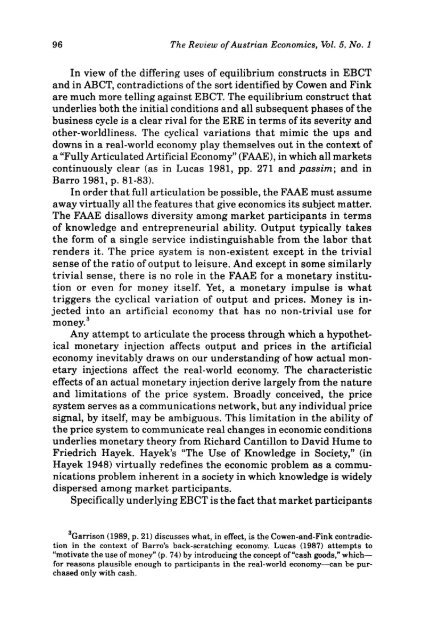Review of Austrian Economics - The Ludwig von Mises Institute
Review of Austrian Economics - The Ludwig von Mises Institute
Review of Austrian Economics - The Ludwig von Mises Institute
Create successful ePaper yourself
Turn your PDF publications into a flip-book with our unique Google optimized e-Paper software.
96 <strong>The</strong> <strong>Review</strong> <strong>of</strong> <strong>Austrian</strong> <strong>Economics</strong>, Vol. 5, No. 1<br />
In view <strong>of</strong> the differing uses <strong>of</strong> equilibrium constructs in EBCT<br />
and in ABCT, contradictions <strong>of</strong> the sort identified by Cowen and Fink<br />
are much more telling against EBCT. <strong>The</strong> equilibrium construct that<br />
underlies both the initial conditions and all subsequent phases <strong>of</strong> the<br />
business cycle is a clear rival for the ERE in terms <strong>of</strong> its severity and<br />
other-worldliness. <strong>The</strong> cyclical variations that mimic the ups and<br />
downs in a real-world economy play themselves out in the context <strong>of</strong><br />
a "Fully Articulated Artificial Economy" (FAAE), in which all markets<br />
continuously clear (as in Lucas 1981, pp. 271 and passim; and in<br />
Barro 1981, p. 81-83).<br />
In order that full articulation be possible, the FAAE must assume<br />
away virtually all the features that give economics its subject matter.<br />
<strong>The</strong> FAAE disallows diversity among market participants in terms<br />
<strong>of</strong> knowledge and entrepreneurial ability. Output typically takes<br />
the form <strong>of</strong> a single service indistinguishable from the labor that<br />
renders it. <strong>The</strong> price system is non-existent except in the trivial<br />
sense <strong>of</strong> the ratio <strong>of</strong> output to leisure. And except in some similarly<br />
trivial sense, there is no role in the FAAE for a monetary institution<br />
or even for money itself. Yet, a monetary impulse is what<br />
triggers the cyclical variation <strong>of</strong> output and prices. Money is injected<br />
into an artificial economy that has no non-trivial use for<br />
money. 3<br />
Any attempt to articulate the process through which a hypothetical<br />
monetary injection affects output and prices in the artificial<br />
economy inevitably draws on our understanding <strong>of</strong> how actual monetary<br />
injections affect the real-world economy. <strong>The</strong> characteristic<br />
effects <strong>of</strong> an actual monetary injection derive largely from the nature<br />
and limitations <strong>of</strong> the price system. Broadly conceived, the price<br />
system serves as a communications network, but any individual price<br />
signal, by itself, may be ambiguous. This limitation in the ability <strong>of</strong><br />
the price system to communicate real changes in economic conditions<br />
underlies monetary theory from Richard Cantillon to David Hume to<br />
Friedrich Hayek. Hayek's "<strong>The</strong> Use <strong>of</strong> Knowledge in Society," (in<br />
Hayek 1948) virtually redefines the economic problem as a communications<br />
problem inherent in a society in which knowledge is widely<br />
dispersed among market participants.<br />
Specifically underlying EBCT is the fact that market participants<br />
3 Garrison (1989, p. 21) discusses what, in effect, is the Cowen-and-Fink contradiction<br />
in the context <strong>of</strong> Barro's back-scratching economy. Lucas (1987) attempts to<br />
"motivate the use <strong>of</strong> money" (p. 74) by introducing the concept <strong>of</strong> "cash goods," which—<br />
for reasons plausible enough to participants in the real-world economy—can be purchased<br />
only with cash.

















